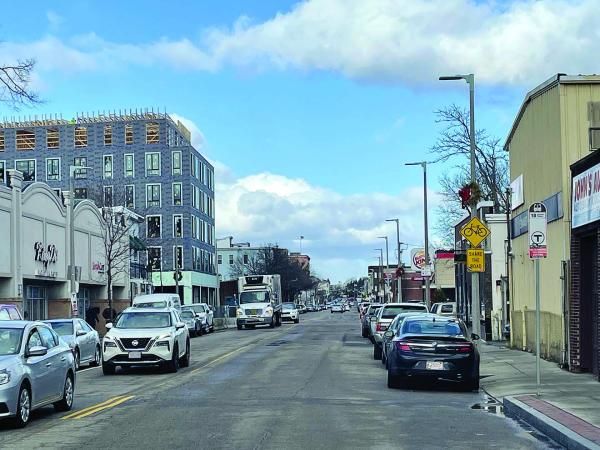January 19, 2022

Dorchester Avenue is embarrassing. Though certain sections, like the Lower Mills area adjacent to Milton, are better planned and developed, the northern half is an uneven mess.
Dot Ave, as residents refer to it, is supposed to be Dorchester’s prestigious main street for businesses and services, and a thoroughfare for travel to downtown, but it does none of these things well.
The short drive from Savin Hill Avenue to Columbia Road can take 15 minutes in the morning. Bike riders take their lives in their hands trying to navigate the narrowness of the avenue, which lacks a coherent feel; it’s a hodgepodge of industrial and commercial spaces, housing, and parking lots.
And yet the Boston Planning and Development Agency (BPDA) is allowing multiple housing developments involving hundreds of units to be built in the area without dealing with Dot Ave’s deficiencies. Why? Because the BPDA takes each development as if it is the only development going on, and its transportation impact reports do not consider the cumulative impact of multiple developments, and what would be needed to accommodate them. To get all this done, Dot Ave needs a makeover.
As a 50-year-Dorchester resident, I’ve seen plans for Dorchester Avenue come and go with little change other than additional traffic lights. The Flynn and Menino administrations both announced plans to fix the Ave. I remember Mayor Menino talking about it as a street that was so difficult to drive down “you can start your trip on one end of Dorchester Avenue at breakfast time, and by the time you get to the other end, it’s dinner time.”
In 2005, Menino created “the Dorchester Avenue Project,” and hired a firm to come up with a follow-through plan. The project’s goals were to enhance the pedestrian environment, improve traffic flow, support existing neighborhood housing and businesses, and develop preliminary designs for streetscape and transportation improvements. Ultimately, in 2008, this led to a $12 million rebuild of the Glover’s Corner and Fields Corner intersections, along with the synchronization of some traffic lights.
A reasonable person would conclude that city planners are incapable of figuring out how to make Dot Ave work for Dorchester residents. And so, it was refreshing when Michael Keamy, a neighborhood resident, formed the “Dorchester Avenue Vision Committee (DAVC),” which called a meeting last May for those interested in “meet(ing) passionate and like-minded neighbors committed to guiding Dorchester Avenue into a better future! Bring your eyes, a pen and notebook, your talents and ideas. We will look at the Avenue with fresh eyes and see what works great, what could use improvement, and explore what actions can be taken to help make the change.”
The group’s focus is the section of the Ave between Columbia Road and Freeport Street. Its ambition is to develop the plan that has eluded city government, but to start with a greening plan on the basis that one way to create coherence and beauty is to have trees and plantings all along the roadway. Michael asked for volunteers to walk the avenue and come up with a proposal.
This is important because the way the city allocates trees runs counter to the needs of a main street with such diverse uses. Boston typically plants a tree when a resident requests one and the location meets certain requirements. In this case, the request would be for many trees and rain gardens (small plots with greenery typically at intersections) at various locations.
On Nov. 1, a group of volunteers —myself included— walked the Avenue and looked at current plantings between Columbia and Freeport. We found some blocks with sufficient trees, but many without a single one. We mapped out locations for trees and rain gardens, and outlined the area between Freeport and Bay Street as a section with so much development and construction in process that professional landscape architectural help is needed to develop a greening plan.
We are working with a group named Speak for the Trees to ensure the newly planted trees will be watered during the summer months, when so many new trees die from lack of water. We found a volunteer with a wonderful name for this effort, Charlotte Shade, who provided the electronic map that identifies locations for 30 trees and 8 gardens. Michael Keamy worked up a change.org petition asking residents to support this greening effort. As of Jan. 18, more than 600 people have signed it. You can find the petition and plan at https://chng.it/2MsRWJPg, or just google “change.org Boston trees.” You can join DAVC by writing to Dorchesteravc@gmail.com.
DAVC plans to provide the plan and petition to Mayor Wu and our city councillors, asking them for support in getting trees and rain gardens along Dorchester Avenue. We urge community groups south of Freeport Street to undertake their own planning efforts to make the thoroughfare greener.
Dorchester Avenue is the main street of what would be one of the largest cities in Massachusetts were it separate from Boston. The Wu administration is committed to increasing the tree canopy of Boston. The Dorchester Avenue greening plan is ready to go.
Bill Walczak is a Dorchester resident. He is the founding president and former CEO of the Codman Square Health Center.
a href="https://www.dotnews.com/subscribe">


